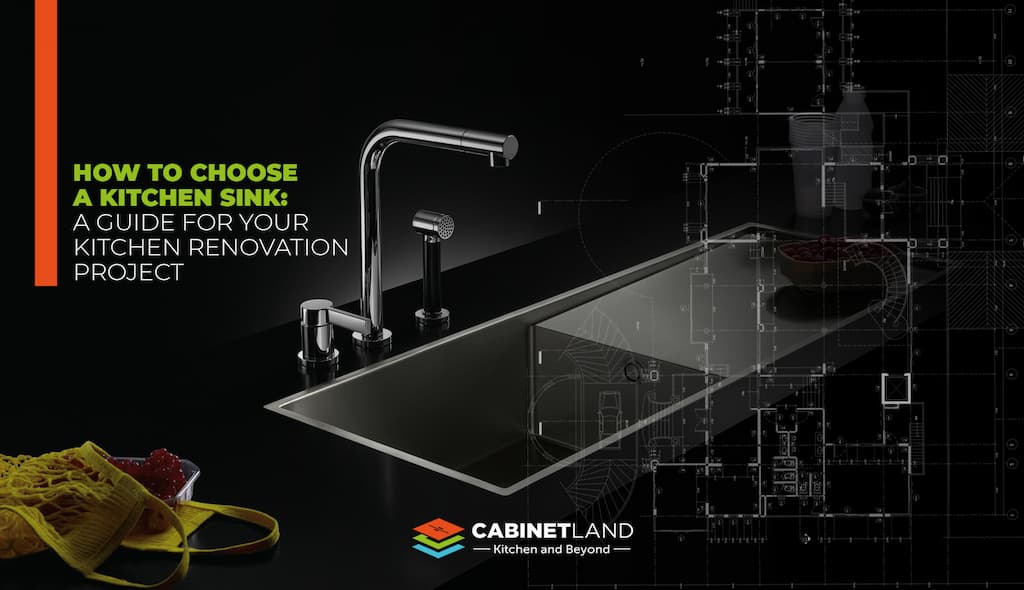Choosing your kitchen sink is more than a mere functional necessity; it’s a statement of style, a nod to practicality, and an integral component of your kitchen’s overall design. In this comprehensive guide, we explore the myriad factors that shape this important decision: From understanding the interplay of space and functionality and exploring various sink types and materials to aligning with your kitchen’s aesthetic and practical demands, we cover every angle to aid your selection.
Table of Contents
ToggleWe’ll assess your kitchen’s layout to determine the best sink size and style, evaluate material choices for durability and maintenance, and understand different installation methods. The guide also addresses the importance of faucet compatibility, storage options, and budget considerations, including a look at top brands. Plus, we keep you informed about the latest trends in kitchen sink designs, ensuring your choice meets your current needs and aligns with contemporary styles and innovations.
This guide is designed to be your ally in navigating the vast world of kitchen sinks. By considering each aspect carefully, you’ll be well-equipped to choose a sink that integrates seamlessly into your kitchen renovation project and enhances your daily kitchen experience in both function and form.
What are The Considerations When Selecting a Kitchen Sink?
- Space and Functionality
- Sink Styles
- Sink Types and Aesthetic
- Practicality and Durability
- Installation Types
- Faucet Holes and Compatibility with Faucets
- Storage Options
- Size Considerations
- Price and Brand Options
- New Bathroom Sink Trends
1. Space and Functionality
When selecting a kitchen sink as part of your renovation project, understanding the space available and how the sink will function in your daily life is crucial. Here’s a detailed look at the factors to consider:
- Measure Your Space: Start by measuring the available countertop and cabinet space where you plan to install the sink. This will determine the maximum size of the sink you can accommodate.
- Sink Placement: Consider the best placement for your sink based on your kitchen’s layout. It should be accessible, complement the work triangle (the space between your stove, refrigerator, and sink), and not interfere with kitchen traffic.
- Cabinet Size: The size of the cabinet beneath the sink (sink base) also plays a crucial role. Standard base cabinets range from 24 to 36 inches (60.96 to 91.44 cm), which can dictate the type and size of the sink you can install.
- Usage Patterns: Reflect on how you use your kitchen. Do you cook often or entertain regularly? If so, you might benefit from a larger or double-bowl sink. If your kitchen use is more moderate, a single bowl might suffice.
- Sink Depth: Deeper sinks are great for washing large pots and pans but can also cause strain if you bend over for long periods. The depth of a kitchen sink can vary from 7 to 10 inches (18 to 25 cm). Find a balance between depth and comfort.
- Material and Durability: Choose materials that can withstand your kitchen activities. Stainless steel is popular for its durability and ease of maintenance, while materials like granite composite offer aesthetic appeal and resistance to scratches and chips.
- Ease of Maintenance: Consider how easy it is to clean and maintain the sink. Some materials and finishes might require more regular upkeep than others.
- Nearby Appliances: The sink should be conveniently located with the dishwasher and garbage disposal for efficient cleanup.
- Workflow Optimization: A well-placed sink can significantly improve your kitchen workflow. It should allow easy access to commonly used areas and appliances without causing congestion.
The right kitchen sink balances space considerations with functionality. It should fit comfortably within your kitchen’s layout, cater to your usage needs, and integrate seamlessly with your kitchen workflow. Carefully evaluating these aspects will ensure that your kitchen sink is a functional tool and an integral part of your kitchen’s design and efficiency.
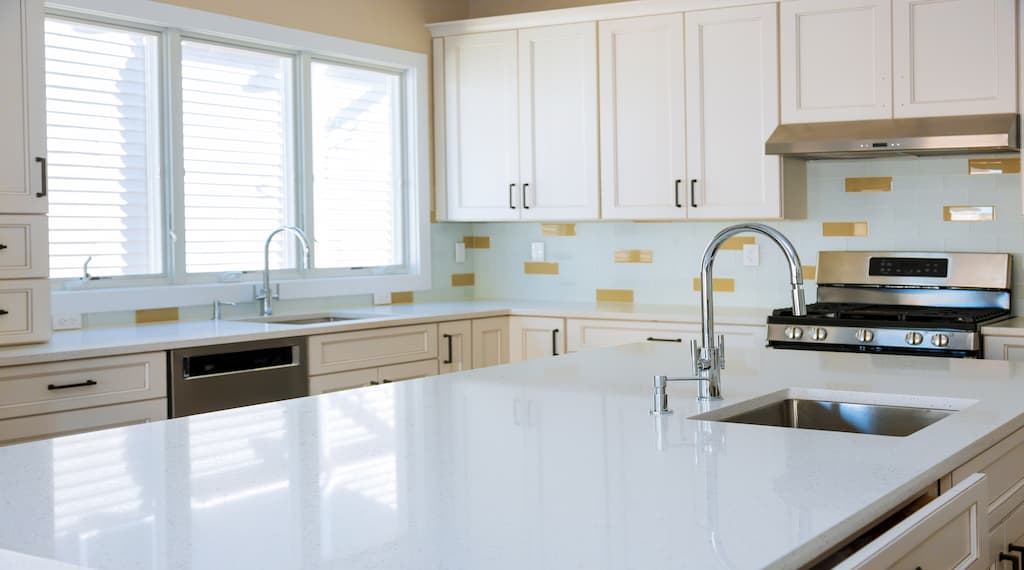
2. Kitchen Sink Styles
Choosing a kitchen sink involves balancing practicality with aesthetics. The type of sink you select can significantly impact your kitchen’s overall look and feel. Here’s an in-depth look at different sink types and their aesthetic implications:
What are The Kitchen Sink Types?
- Stainless Steel Sinks: Stainless steel sinks fit seamlessly into most kitchen designs, particularly those with a contemporary or industrial aesthetic, known for their durability and modern appeal. They are resistant to heat and stains, making them a practical choice. However, they can show water spots and scratches over time.
- Ceramic Sinks: Ceramic sinks are popular for traditional or country-style kitchens, offering a classic and clean look. Though white is the most common, they are available in various shapes and colors, providing a timeless elegance.
- Granite Composite Sinks: These sinks are known for their robustness and luxurious appearance. They come in a range of colors and offer a unique texture that can add depth to your kitchen’s design. Granite composite sinks are also highly resistant to scratches and chips.
- Cast Iron Sinks: Often coated in enamel, cast iron sinks are durable and come in various colors. Their glossy finish can add a touch of sophistication to your kitchen but requires regular maintenance to keep their shine.
- Copper Sinks: Copper sinks add a distinctive, rustic charm to a kitchen and develop a patina over time, which can add character. They require special care to maintain their appearance.
What Are The Aesthetic Considerations?
- Harmony with Kitchen Style: Your sink should complement the overall style of your kitchen. For instance, a sleek stainless steel sink may suit a modern, minimalist kitchen, while a ceramic farmhouse sink could be the centerpiece in a more traditional setting.
- Color and Finish: Consider the color and finish of the sink concerning your countertops, cabinetry, and kitchen appliances. The right contrast or color coordination can create a harmonious and aesthetically pleasing kitchen.
- Sink Shape and Design: The shape and design of the sink also contribute to the kitchen’s aesthetic. While traditional sinks are often rectangular, modern designs offer various geometric shapes and creative designs that can be focal points.
What is The Impact of Kitchen Types on Kitchen Renovation?
- Visual Appeal: The right sink can elevate the overall look of your kitchen, especially during a renovation. It’s an opportunity to update the style and add a new element to your space.
- Resale Value: An aesthetically pleasing and functional sink can also increase the appeal and value of your home, which is an important consideration if you plan to sell in the future.
When choosing a kitchen sink, consider both the type of sink and its aesthetic impact on your kitchen. It should not only meet your functional needs but also enhance the visual appeal of your kitchen, ensuring that it complements the overall design and adds value to your renovation project.
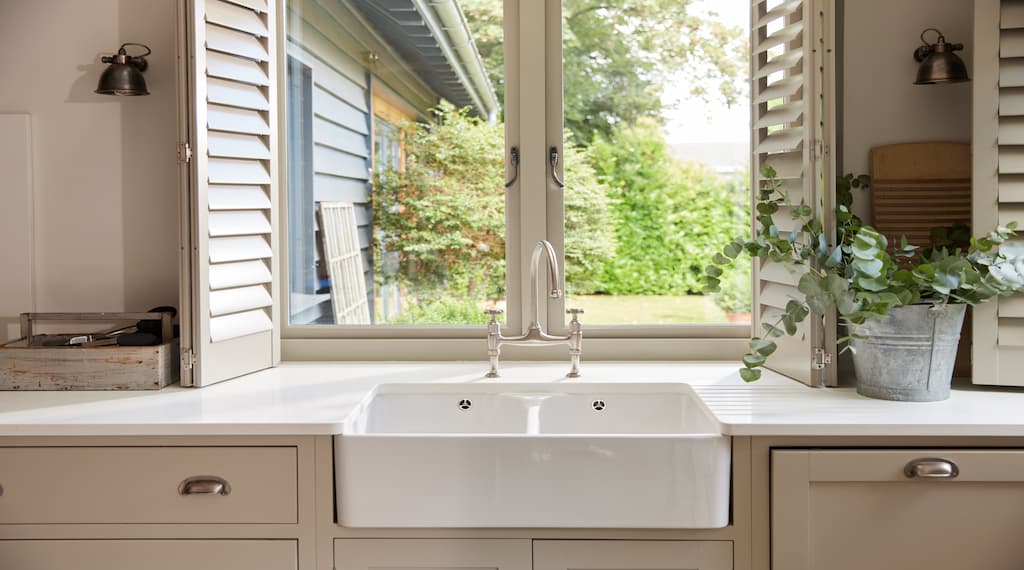
3. Practicality and Durability
When it comes to kitchen renovations, selecting a sink that combines practicality with durability is essential. This choice impacts not only your kitchen’s daily use and functionality but also its long-term resilience and maintenance requirements.
- Stainless Steel: A popular choice due to its robustness, stainless steel resists rust and stains. It’s also lightweight and easy to install. However, it can be prone to scratches and water spots, requiring regular maintenance.
- Ceramic and Porcelain: These materials are ideal for heavy usage, known for their hardness and resistance to chipping. They are easy to clean but can crack under severe impact.
- Granite Composite: These sinks are highly durable, resisting scratches, chips, and heat damage. They offer a balance of practicality and aesthetic appeal but may require specific cleaning agents to prevent surface damage.
- Cast Iron with Enamel Coating: Extremely durable and heavy, these sinks can last for decades. The enamel coating, however, can chip over time, and the sink might require re-enameling.
- Copper: While visually striking, copper sinks require more maintenance to prevent tarnish and maintain their shine. They are also naturally antimicrobial, a practical feature for hygiene.
What are The Practical Design Considerations?
- Depth and Size: Deeper sinks allow for easier washing of large pots and pans, enhancing functionality. However, they may require bending over, which can be uncomfortable for some users.
- Single vs. Double Basin: Single basin sinks offer more space for washing large items, while double basins are useful for multitasking but offer less room for larger dishes.
- Ease of Cleaning: The sink design should allow for easy cleaning. Undermount sinks, for instance, don’t have a lip on the countertop, making it simpler to wipe debris directly into the sink.
- Noise Reduction: Stainless steel sinks can be noisy. Look for options with sound-dampening pads or coatings to reduce noise during use.
What are The Kitchen Sinks’ Practicality and Durability Considerations for Kitchen Renovation?
- Matching with Countertops: Choose a sink material and style that complements the countertops you plan to install or already have. The sink should integrate seamlessly into the overall design.
- Installation Type: The installation method can affect both the look and functionality. For instance, undermount sinks offer a sleek look but require a solid countertop material like granite or marble.
- Long-Term Value: Durability ensures that the sink withstands daily use without requiring frequent replacements or repairs, adding long-term value to your kitchen renovation.
The practicality and durability of a kitchen sink hinge on the right balance between material choice, design features, and maintenance requirements. A well-chosen sink not only eases daily kitchen tasks but also stands the test of time, making it a wise investment in any kitchen renovation project.
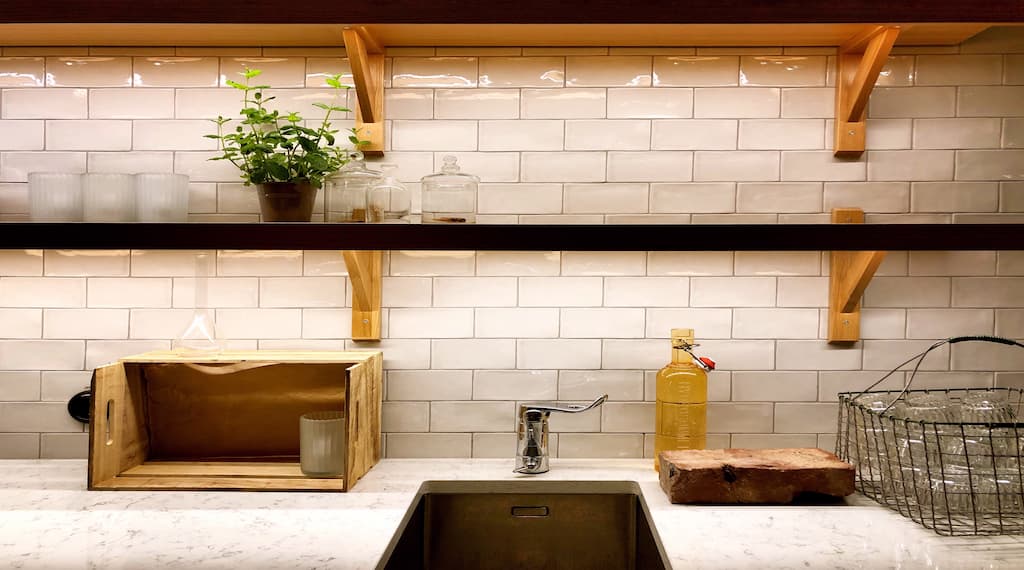
4. Installation Types: Navigating Kitchen Sink Mounting Options
In kitchen renovation, the installation type of your sink is a pivotal decision that influences your kitchen’s aesthetics and functionality. Different mounting options cater to diverse styles and practical needs. Understanding these types can guide you in making an informed choice for your kitchen sink.
Top-Mount or Drop-In Sinks
Characteristics: These sinks have a visible lip around their edge that rests on the countertop. They are designed to be dropped into a pre-cut hole in the countertop.
Advantages: Easy to install and compatible with most countertop materials. Ideal for DIY installations and often more budget-friendly.
Considerations: The lip can accumulate crumbs and water, requiring regular cleaning around the edges. They may not have the seamless appearance of other installation types.
Undermount Sinks
Characteristics: These sinks are mounted underneath the countertop and provide a sleek, seamless look. They are attached to the underside of the countertop material. Advantages: Easy to clean – debris can be swept directly from the counter into the sink without obstruction. Offers a modern, minimalist appearance.
Considerations: Typically, it is more expensive and requires professional installation. They are best paired with solid countertop materials like granite or quartz.
Farmhouse or Apron Front Sinks
Characteristics: These sinks have a distinctive exposed front extending slightly over the cabinetry’s edge.
Advantages: Adds a rustic or traditional charm to the kitchen. The deep basin is practical for large pots and pans.
Considerations: May require custom cabinetry. The installation is more complex and might be more costly.
Integrated Sinks
Characteristics: These sinks are made from the same material as the countertop, creating a continuous, unified appearance.
Advantages: Easy to clean with no crevices or seams. Offers a high-end, custom look.
Considerations: Can be expensive as they often require custom fabrication. Limited to materials compatible with countertop fabrication like solid surfaces.
Wall-Mounted Sinks
Characteristics: These sinks are attached directly to the wall, freeing up the floor space beneath.
Advantages: Maximizes floor space, making it ideal for smaller kitchens. Offers a clean, open look.
Considerations: Plumbing is often exposed, which may affect the aesthetics. Not suitable for heavy-duty use as they lack countertop support.
Aligning with Your Kitchen Renovation Goals
Style Consistency: Choose an installation type that complements your kitchen’s overall design theme. For instance, a farmhouse sink may suit a country-style kitchen, while an undermount sink suits modern aesthetics.
Space Optimization: Consider how the installation type interacts with your kitchen’s space. In smaller kitchens, a wall-mounted or undermount sink might be preferable to save space.
Budget and Installation Constraints: Factor in the installation cost and compatibility with existing cabinetry and plumbing. Some types might require additional structural modifications.
Selecting the right installation type for your kitchen sink is a blend of aesthetic preference, practical considerations, and alignment with your kitchen renovation plan. Each type offers unique benefits and challenges, so weigh these factors carefully to ensure your new kitchen sink enhances your kitchen’s look and functionality.
6. Faucet Compatibility
Understanding the compatibility between your chosen kitchen sink and the faucet is crucial. This pairing needs to be physically compatible and should align in style and functionality to enhance the kitchen design. Some key considerations for matching sink and faucet are:
- Faucet Hole Configuration: Different sinks come with varying pre-drilled hole configurations. It’s essential to match the faucet to these specifications. For instance, a single-hole faucet won’t fit a sink designed for a three-hole faucet layout unless adaptors or cover plates are used.
- Spout Height and Reach: The faucet should match the sink size. A high-arch spout might be necessary for deep basins or farmhouse sinks to provide ample clearance. A standard height faucet can be more appropriate for shallow basins to prevent splashing.
- Style Synchronization: The sink and faucet should complement each other aesthetically. A sleek, modern faucet pairs well with an undermount stainless steel sink, while a more ornate or traditional faucet design suits a classic ceramic or farmhouse sink.
- Finish Coordination: Coordinating the faucet’s finish with the sink and other kitchen hardware (like cabinet handles and drawer pulls) creates a cohesive look. Popular finishes include chrome, stainless steel, brushed nickel, and matte black, each offering a different aesthetic appeal.
- Water Flow and Features: Consider the faucet’s water flow and additional features like sprayers or touchless operation, which can enhance the sink’s functionality. For instance, pull-down sprayers are useful for large or deep sinks, providing flexibility for cleaning and rinsing.
What are The Practical Tips for Faucet Compatibility?
- Measure Accurately: Ensure the spout reach is adequate to cover the sink’s width and that the height doesn’t cause splashing outside the basin.
- Check Under the Sink: Evaluate the space under the sink to ensure there’s enough room for the faucet’s hardware and plumbing connections.
- Consider Future Upgrades: Choose models that will likely be compatible with various styles and configurations if you plan to upgrade the faucet or sink.
- Seek Professional Advice: Consulting with a kitchen renovation expert or plumber can provide insights into the best faucet-sink combinations, especially for unique or custom installations.
The right faucet and sink combination can significantly elevate your kitchen’s functionality and style. By carefully considering factors like hole configuration, spout height, style, and finish, you can ensure a harmonious and efficient pairing that complements your kitchen renovation goals. Remember, the sink and faucet are items for daily use in your kitchen, so their compatibility is key to a satisfying kitchen experience.
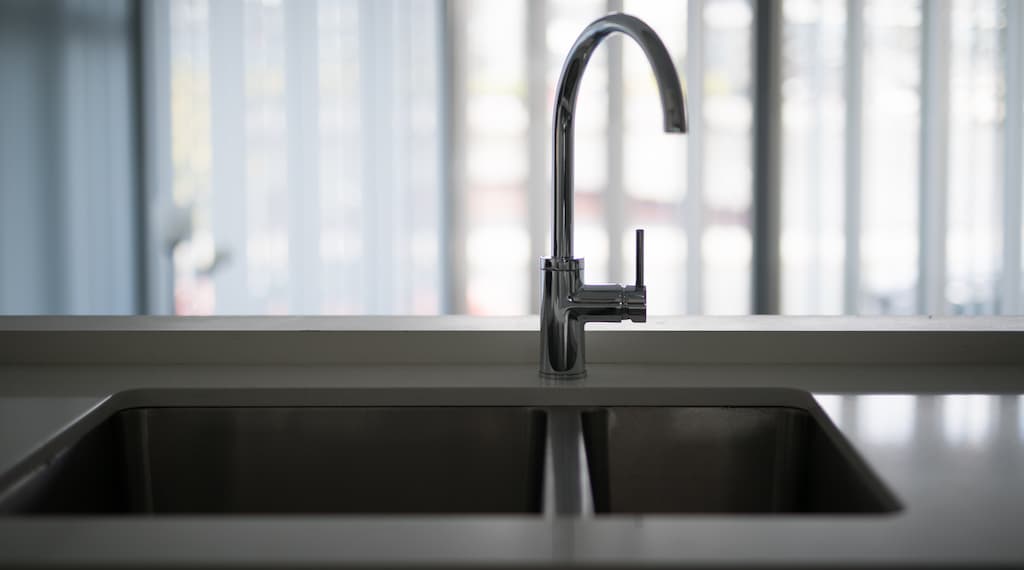
7. Storage Options
Below, you will find 4 types of kitchen sinks and how they determine storage limitations in your kitchen:
- Undermount and Top-Mount Sinks: When paired with a cabinet base, these traditional sink types offer substantial storage space beneath the sink. This space is ideal for housing cleaning supplies and other kitchen essentials. The key is to choose a cabinet that accommodates the sink’s plumbing while providing ample storage.
- Farmhouse Sinks: While farmhouse sinks add aesthetic appeal, their deep basin design may reduce under-sink storage space. It’s important to plan for a cabinet that can accommodate both the sink’s depth and necessary storage.
- Corner Sinks: Corner sinks can be a smart choice for optimizing limited kitchen space. They can free up more counter space and potentially provide additional storage options under the corner cabinet.
- Integrated Sink Countertops: Integrated sinks, where the sink is part of the countertop material, often offer a streamlined look with fewer crevices and seams. This can mean more usable space on the countertop but doesn’t necessarily affect under-sink storage.
How can You Maximize Storage with Sink Selection?
- Utilize Sink Cabinets: Choose a sink cabinet designed to make the most of the available space. Look for designs with built-in organizers or pull-out shelves to maximize the utility of the under-sink area.
- Consider Pull-Out Faucets: A pull-out faucet can add functionality, especially in kitchens with limited space, as it allows for more effective use of the sink area.
- Opt for Multi-functional Sinks: Some modern sinks come with built-in accessories like cutting boards, colanders, and drying racks, which can enhance functionality without needing additional storage space.
Storage considerations are crucial when selecting a kitchen sink for your renovation. By understanding how different sink types impact storage space and seeking innovative solutions, you can ensure that your kitchen is functional and aesthetically pleasing without compromising essential storage needs.
8. Size Considerations
The size of the kitchen sink is a critical aspect of your kitchen renovation, as it must balance the room’s aesthetics with functionality and practicality.
What are The Key Factors in Sink Size Selection?
- Kitchen Size and Layout: Your kitchen’s overall size and layout dictate the appropriate sink size. A large, multi-basin sink may be suitable for spacious kitchens, while compact or single-basin sinks are ideal for smaller kitchens.
- Counter Space: Consider the amount of counter space you have. A larger sink can reduce available workspace, so balancing sink size and counter area is important.
- Cabinet Size: The size of the base cabinet where the sink will be installed is a limiting factor. Ensure the sink dimensions align with the cabinet size, leaving enough room for installation and plumbing.
- Depth of the Sink: Deep sinks can accommodate large pots and pans, making kitchen tasks more manageable. However, too deep sinks can be uncomfortable for shorter individuals or those with back issues.
What are The Standard Measurements and Custom-Sized Sink?
- Standard Sizes: Most kitchen sinks come in standard sizes, typically 22 by 30 inches (59 by 76 cm) in width. The most common size of an undermount kitchen sink is 22 inches (56 cm) in width and 30 to 33 inches (76 to 84 cm) in length. The depth can vary but usually falls between 8 to 10 inches (20.32 to 25.4 cm). The diameter of a round kitchen sink is usually 15 to 20 inches (38 to 51 cm).
- Custom Sizes: Custom-sized sinks are an option for unique kitchen layouts or specific needs. They allow for greater flexibility in design and can be tailored to fit your kitchen’s specific dimensions and style.
3 Practical Considerations of Kitchen Sinks
- Family Usage: Consider the size and number of people using the kitchen. A larger family or frequent entertainers might benefit from a larger or double-basin sink.
- Sink Accessories: Some sinks offer accessories like cutting boards or drying racks that fit within the basin, adding functionality to smaller sinks.
- Aesthetics vs. Functionality: It’s important to balance aesthetic appeal with practical use and available space, while a large sink can be an attractive focal point.
Choosing the right size for your kitchen sink involves considering various factors, including kitchen size, layout, and personal needs. Whether opting for a standard or custom-sized sink, the right choice will enhance your kitchen’s functionality and appearance, making it a crucial element in your renovation project.
9. Price and Brand Options
When selecting a kitchen sink, understanding your budget and the available brands is crucial. This knowledge ensures you get the best value and quality for your investment.
What is The Price Range for Kitchen Sinks?
- Economy and Mid-Range Options: Basic kitchen sinks, typically made of stainless steel or basic composite materials, can range from $100 to $300. These options are practical and offer decent durability for regular use.
- Premium Options: High-end sinks, especially those made from copper, high-grade stainless steel, or natural stone, can range from $500 to over $1,000. These sinks often come with additional features and unique designs.
What are The Recommended Brands for Best Value?
- Kohler: Known for its wide range of styles and materials, Kohler offers sinks that cater to various budgets, with prices generally ranging from $200 to $800.
- Blanco: Specializing in granite composite and stainless steel sinks, Blanco is renowned for durability and design. Prices typically range from $250 to $700.
- Elkay: Elkay’s sinks are priced from $150 to $600 and offer a variety of materials, including stainless steel, copper, and quartz.
- Franke: A leader in innovative kitchen solutions, Franke’s sinks range from mid-range to premium prices, often between $300 and $1,000.
- Ruvati: Known for its stainless steel and granite sinks, Ruvati offers stylish yet affordable options, ranging from $200 to $500.
- MSI: Known for its diverse range of materials and styles, MSI offers sinks priced from mid-range to premium, generally between $200 and $600.
- Chemcore: With options in stainless steel and composites, Chemcore is recognized for affordability without compromising quality, with prices usually ranging from $100 to $300.
- Ticor: Specializing in stainless steel sinks, Ticor provides durable and stylish options, generally priced between $150 and $400.
- Brita Sinks: Known for quality and design, Brita Sinks tends to fall in the mid to upper price range, varying from around $250 to over $500.
- Delta Sink: Offering a variety of designs that balance quality with affordability, Delta Sink’s prices range from about $100 to $300.
Choosing the right kitchen sink involves balancing quality, aesthetics, and budget. Understanding the pricing and what different brands offer helps you make an informed decision that aligns with your kitchen renovation goals and financial constraints.
10. New Kitchen Sink Trends
Staying updated with the latest trends in kitchen sink design can significantly influence your renovation choices, ensuring your space remains contemporary and functional.
What are The Current Trends in Kitchen Sink Designs?
- Minimalist and Sleek Designs: A trend towards minimalist design continues with sinks featuring clean lines and simple, uncluttered styles. Undermount sinks, with their seamless integration, are particularly popular for this look.
- Eco-Friendly Materials: There’s a growing emphasis on sustainability, with recycled materials and eco-friendly manufacturing processes becoming more prevalent. Brands are now offering sinks made from recycled metals and sustainable composite materials.
- Bold Colors and Patterns: Kitchen sinks are now available in various colors and finishes, allowing for more personalized kitchen aesthetics and moving away from traditional stainless steel and white porcelain sinks.
- Smart Sinks: Technology integration in kitchen sinks is on the rise. Features like touchless faucets, built-in water filtration systems, and sinks with IoT connectivity are becoming more common.
What are The Innovative Features of Modern Kitchen Sinks?
- Integrated Workstations: Kitchen sinks are now designed with built-in accessories like cutting boards, colanders, and drying racks, adding functionality and saving space.
- Customizable Options: Customization is key, with many manufacturers offering kitchen sinks tailored in size, style, and even color.
- Multi-Functional Sinks: Designs that combine various functions, such as prep and clean-up areas, are becoming popular, offering efficiency and improved workflow in the kitchen.
The latest trends in kitchen sink design focus on combining functionality with style. Whether through sustainable materials, integrated technologies, or customizable options, today’s kitchen sinks offer a wide range of innovative features that can enhance your kitchen renovation project, making it a blend of practicality and modern aesthetics.

What are The Other Important Considerations for Houseowers When Selecting Kitchen Sinks?
When homeowners select a kitchen sink for the kitchen renovation project, several important considerations go beyond the basic aesthetics and functionality. Environmental and health impacts are increasingly vital, with many opting for eco-friendly materials and lead-free constructions for safer use. Sink accessories, such as bottom grids and soap dispensers, add functionality and convenience. Water and energy efficiency are also key, with options like low-flow faucets reducing utility bills and conserving resources. Additionally, the future resale value of the home can be influenced by the choice of the sink, where high-quality, durable materials and timeless designs can significantly increase attractiveness to potential buyers.
Environmental and Health Considerations
When selecting a kitchen sink as part of a kitchen renovation, considering environmental and health impacts is increasingly important for many homeowners.
Eco-Friendly Materials
- Recycled Materials: Sinks made from recycled or sustainable materials, like recycled stainless steel or composite, offer an environmentally friendly choice.
- Natural Stone: Natural stone sinks, though not recycled, are durable and long-lasting, reducing the need for replacements and minimizing waste.
- Lead-Free Construction: For health safety, ensure the sink and its components (like faucets) are lead-free, especially in older homes where lead pipes might have been used.
Health-Focused Choices
- Non-Toxic Sealants: Look for sinks that use non-toxic sealants and adhesives, which reduce the release of harmful chemicals.
- Anti-Microbial Coatings: Some modern sinks come with anti-microbial coatings that inhibit the growth of bacteria and mold, ensuring a healthier kitchen environment.
Sink Accessories
The right accessories can significantly enhance the functionality of your kitchen sink.
What are The Essential Accessories for Kitchen Sinks
- Bottom Grids: These protect the sink’s surface from scratches and dents, extending its life.
- Drain Strainers and Covers: Strainers prevent clogging by catching debris, while covers can offer a more streamlined look.
- Soap Dispensers: Built-in soap dispensers add convenience and can maintain the kitchen’s aesthetic appeal.
Customizing Your Sink
- Cutting Boards: Some sinks accommodate custom-fitted cutting boards, increasing counter space.
- Colanders and Rinse Baskets: These can be essential for food preparation and cleaning.
Water and Energy Efficiency
Selecting a sink that complements water and energy-saving practices can be vital to a sustainable kitchen renovation.
- Deep Basins: Deeper sinks can reduce water splash and wastage, which is especially useful for heavy kitchen use.
- Compatibility with Low-Flow Faucets: Choose sinks that work efficiently with low-flow faucets to reduce water usage without compromising performance.
Future Resale Value
A well-chosen kitchen sink can enhance the resale value of your home.
What are The Value-Adding Factors?
- Quality Materials: High-quality materials like stainless steel, granite, or ceramic are durable and appealing to potential buyers.
- Timeless Design: Opt for a sink with a design that withstands trends, ensuring it remains appealing for years.
- Brand Reputation: Choosing a sink from a reputable brand can be a selling point, signaling quality and reliability to future buyers.
Incorporating these considerations into your decision-making process ensures that your kitchen sink choice is practical, aesthetically pleasing, environmentally responsible, health-conscious, and a valuable investment in your home’s future.
To Sum Up
Selecting the right kitchen sink for your kitchen renovation project goes beyond a functional necessity. It’s about crafting a space that resonates with your lifestyle, complements your aesthetic preferences, and upholds environmental and health standards. From considering the practicality of different materials and sizes to understanding installation types and faucet compatibility, each element plays a pivotal role in ensuring your kitchen sink is not just a practical fixture but a testament to your taste and sustainable living.
Embrace the latest trends, but anchor your choice in timeless practicality and durability. Let your chosen sink enhance the kitchen’s functionality, contribute positively to the environment, and boost your home’s resale value. With careful consideration and a keen eye for detail, your kitchen sink can become a cornerstone of your kitchen’s transformation, blending seamlessly into the tapestry of your renovated space and enriching your daily culinary experiences.

